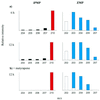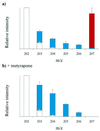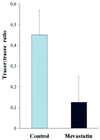An alternative cytokinin biosynthesis pathway
- PMID: 11114204
- PMCID: PMC18995
- DOI: 10.1073/pnas.260504097
An alternative cytokinin biosynthesis pathway
Abstract
Studies of de novo cytokinin biosynthesis in isopentenyltransferase (ipt)-transformed Arabidopsis thaliana, involving in vivo deuterium labeling and mass spectrometry, showed that the biosynthetic rate of zeatinriboside-5'-monophosphate was around 66-fold higher than that of isopentenyladenosine-5'-monophosphate (iPMP), the proposed primary product of the Agrobacterium ipt. Double tracer analysis, using [(2)H(6)] isopentenyladenosine and deuterium oxide, provided evidence for an alternative, iPMP-independent, biosynthetic pathway for zeatin-type cytokinins, present in both ipt-expressing and wild-type Arabidopsis thaliana. Reduction of the biosynthetic flux in the alternative pathway by use of mevastatin, an inhibitor for 3-hydroxy-3-methylglutaryl CoA reductase, indicated a terpenoid origin for the side-chain precursor of the iPMP independent pathway.
Figures







References
-
- Miller C O, Skoog F, Von Saltza M H, Strong F M. J Am Chem Soc. 1955;78:1392.
-
- Skoog F, Strong F M, Miller C O. Science. 1965;148:532–533. - PubMed
-
- Mok M C. In: Cytokinins: Chemistry, Activity and Function. Mok D W S, Mok M C, editors. London: CRC; 1994. pp. 155–166.
-
- Swaminathan S, Bock R M. Biochemistry. 1977;16:1355–1360. - PubMed
-
- Klämbt D. In: Physiology and Biochemistry of Cytokinins in Plants. Kaminek M, Mok D W S, Zazímalová E, editors. The Hague: SPB Academic Publishing; 1992. pp. 25–27.
Publication types
MeSH terms
Substances
Grants and funding
LinkOut - more resources
Full Text Sources
Other Literature Sources
Molecular Biology Databases

